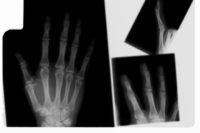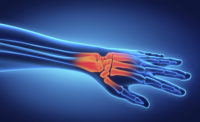Easing texting and email hand pain

Office workers can develop damaged thumbs from texting and emailing on their phones.
Smartphones force your thumb to make repetitive, awkward movements. “We’re getting more thumb and wrist tendonitis,” says Karen Jacobs, an occupational therapist at Boston University and the founding editor of the interdisciplinary journal Work: A Journal of Prevention, Assessment and Rehabilitation. “It’s an issue we all have to be mindful of.”
Abusing the thumb causes a medical condition known as De Quervain’s tenosynovitis. Overuse inflames the tendons and their protective sheaths, which causes pain along the thumb side of the wrist. The pain can result in reduced grip strength and a crippled hand. Tech has abused our hands in the past, but phones create unique problems different than a keyboard or a mouse. “We primarily used our fingers in the past, but now we’re switching to our thumb,” says Natalie Strand, a pain management physician and clinical instructor at the Mayo Clinic Medical School. “We’re seeing different types of stress than we did in the past.”
Here are a few of the easiest recommendations experts gave us to help mitigate the damage.
WORK SMARTER: Jacobs sneaks in breaks without putting her phone away; she keeps common sentences saved so her thumb isn’t typing more than it must. She also recommends voice texting, but be careful: “If you dictate, you need to then proofread,” she says. A simple mistake could cause unnecessary confusion. If possible, put your phone on speaker and place it on a flat surface; clenching your phone while talking puts the hand in an unnatural position.
LOOSEN UP: Getting warm before physical activity goes beyond sports and exercise: “Flexibility is a big part of prevention,” Strand says. Try this routine from Harvard Medical School: Open your hand and face your palm toward yourself. Move your thumb across your palm and touch your thumb to the pinkie side of your hand—or as close as possible. Hold this for five to 10 seconds, and repeat 10 times. Work in three sessions each day.
TAKE MASSAGE BREAKS: You don’t need an appointment or a specialist to give yourself a pain-reducing massage. The Arthritis Foundation recommends gripping your wrist with your other hand, fingers on top of the wrist, and slowly moving your hand up and down your forearm. You can use this “milking” technique on each individual finger as well. Apply pressure with the thumb and index finger and slowly move them to the end of each finger.
STRETCH OUT: Jill Miller, co-founder of Tune Up Fitness Worldwide, finds strengthening techniques can also help prevent pain. She calls one such exercise the "Hand Claw." "Curl each finger and thumb into the palm," Miller says. "Attempt to touch your fingertips into the palm surface while actively extending the fingers and thumb as much as possible." She recommends holding for 30 to 60 seconds and completing five repetitions.
ICE AWAY SWELLING: The idea of icing your thumb and wrist after a long day of texting may seem embarrassing. But what's worse is telling your boss you need to see a doctor to get a corticosteroid injection to reduce the swelling in your thumb—a potential treatment option in the most severe cases. “Icing is a potent anti-inflammatory,” Strand says. The Mayo Clinic recommends 15-20 minutes every four to six hours.
CHANGE YOUR GRIP: Simply switching hands can alleviate overworked tendons. This might sound obvious, but most people don’t give their dominant hand a break until it’s too late. Switch hands as regularly as possible; pain should be a final red flag. “When it starts to hurt, stop,” Strand says.
These techniques will help, but they aren't magic. When possible, put your phone away to give your thumb a break. “People need to take responsibility for staying healthy,” says Jacobs, who is also a certified ergonomist. Her free software is designed to prevent repetitive stress injuries in children through routine stretch breaks. But we adults need breaks just as much. “It’s important to use technology wisely,” she says
Source: Vice.com
Looking for a reprint of this article?
From high-res PDFs to custom plaques, order your copy today!






